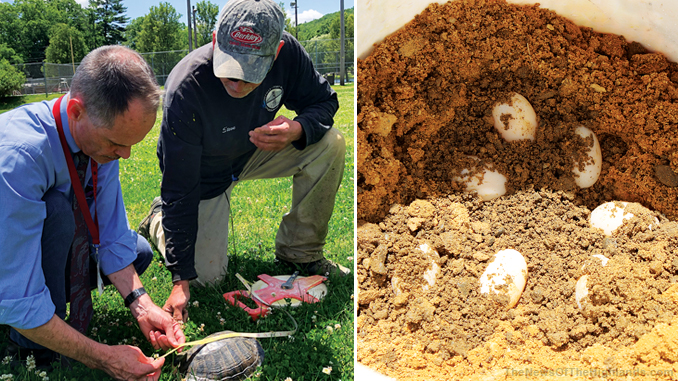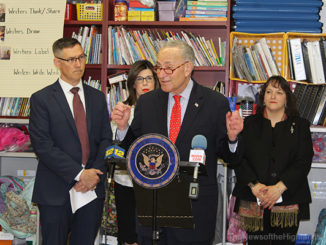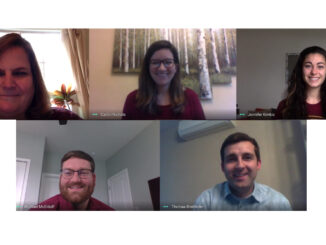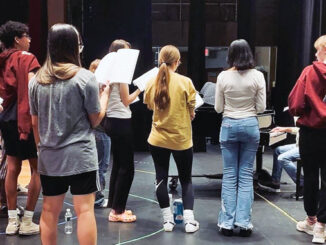
It was all thanks to the combined effort of three
Highland Falls-Fort Montgomery Central School District groundskeeper Steve Chesmin and Town of Highlands Recreation Director Aaron Falk were enjoying a beautiful spring afternoon on Monday, just starting to get the Roe Park baseball field ready for a modified baseball game that afternoon.
Then, Chesmin saw something moving along the baseline between second and third bases. He went closer to take a look.
It was a turtle, quite obviously laying eggs in about a six inch hole she had just dug.
He backed away and left the turtle to her business, kept up with his work, but leaving a wide swath between the tractor he was using and the turtle. As he and Falk kept watching and working, the turtle finished laying the eggs and then replaced all the sandy dirt back over them. She then moved away and started heading back to the Roe Park Pond.
Once turtles lay their eggs, they leave, with no intent to return to the eggs or the baby turtles that eventually are born.
Chesmin and Falk knew they didn’t want to drive their equipment over the eggs they had just watched be laid — “any of our machinery would have crushed those eggs immediately,” Chesmin said.
So instead, they called O’Neill High School Environmental Science teacher Mike Mallon. Mallon immediately grabbed a bucket, hopped in his car and drove to the park.
Chesmin had guessed it, and Mallon confirmed it — the turtle mama was a Red Eared Slider, and was about 10.5 inches long (they measured her). Mallon estimates she’s well over 20 years old.
Red Eared Slider turtles are the most popular pet turtles in the US, but are native to the southern United States and northern Mexico. They’ve become established in other places — apparently like Roe Pond — because of pet releases. Mallon said that people often buy the turtles as pets when they are small, and then release them as they get too large for a home tank.
In nature, the turtles inhabit areas with a source of still, warm water, such as ponds, lakes, swamps, creeks, streams, or slow-flowing rivers, and live in places where they can leave the water easily by climbing onto rocks or tree trunks so they can warm up in the sun. Anyone who walks around Roe Park knows that the turtles which live there do just that.
When Mallon arrived at the park, he first measured and looked at the turtle; they were able to easily pick her up as she made her way back toward the pond. He said it was the largest of this type of turtle he’d seen.
After examining her, the three men went to the spot where she had laid the eggs. First, Mallon shoveled a circle around the area where Chesmin had witnessed her laying the eggs, and then used a narrow tool Falk had (made to pry bases out of the ground) to slowly scrape the dirt away so as not to damage the eggs. He knew just where to look — a very wet circular area indicated the spot.
“Turtles fill up with water just before laying their eggs,” he said,
“so they can use their urine to soften the dirt where they will lay the eggs.”
It didn’t take him to long to start finding eggs — he was able to gently pick all 12 from the ground and place them in the bucket Chesmin and Falk put some of the same wet sand in. The three men gently layered eggs and sand, much like they were in the ground as they were laid.
Then what? Mallon took the bucket back to his classroom at the high school to show his students. It will take about three months for the eggs to hatch — hopefully that will be after school begins in September. For summer vacation, the eggs will go home with Mallon, where he will keep the eggs in the bucket, and misting it frequently to keep the sand the same level of moisture it is now.
Then, once they hatch, he and his students will release them, most likely near Morgan Farm, where his students do a great deal of their research.
Interestingly, this week, an environmental professor from West Point is set to come visit Mallon’s classes, and to help them set some turtle traps at Morgan Farm.
Had the turtle eggs survived the three months under the playing field at the park, they probably would have met with a sad fate after emerging from the sand — they wouldn’t have known which way to the water, for instance, Mallon said.
The science teacher was thrilled that Chesmin and Falk thought to call him. It wasn’t the first go-round of turtle rescuing for Chesmin and Mallon — several years ago 19 snapping turtle eggs were found in a wall at the Fort Montgomery Elementary School. Again, Mallon tended to them, and 18 hatched and were then released.
“I’m so happy they called me,” Mallon said, saying his students would benefit from the find.
As for Falk? He was just happy that they were able to relocate the eggs — “I would have felt terrible if I’d squashed them with my tractor,” he said.



